Roles of Leaders and Managers in Management and Operations
VerifiedAdded on 2023/04/04
|15
|3792
|408
AI Summary
This study explores the roles and responsibilities of leaders and managers in management and operations, including the comparison of different roles, the application of relevant theories and models, and the importance of operations management for achieving business objectives.
Contribute Materials
Your contribution can guide someone’s learning journey. Share your
documents today.
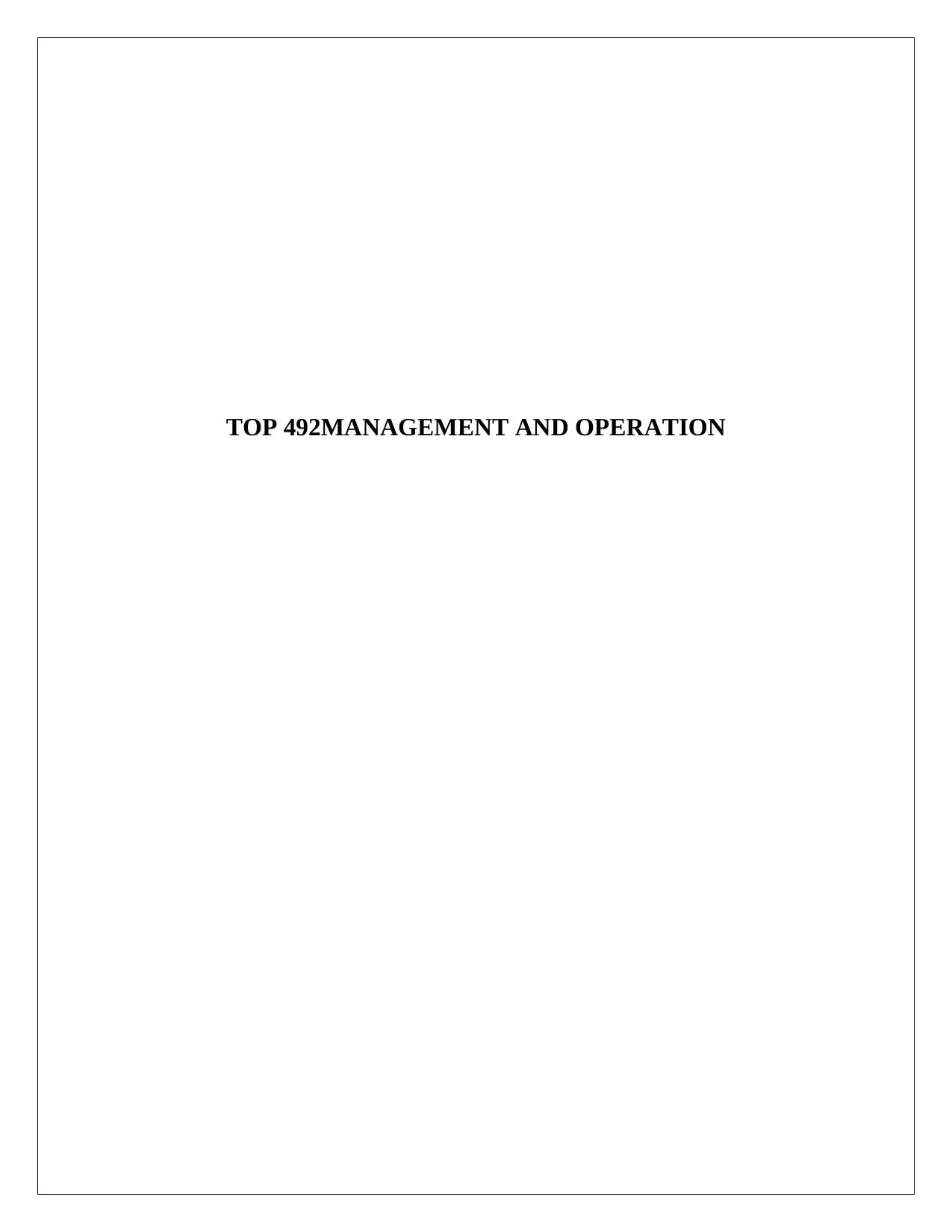
TOP 492MANAGEMENT AND OPERATION
Secure Best Marks with AI Grader
Need help grading? Try our AI Grader for instant feedback on your assignments.
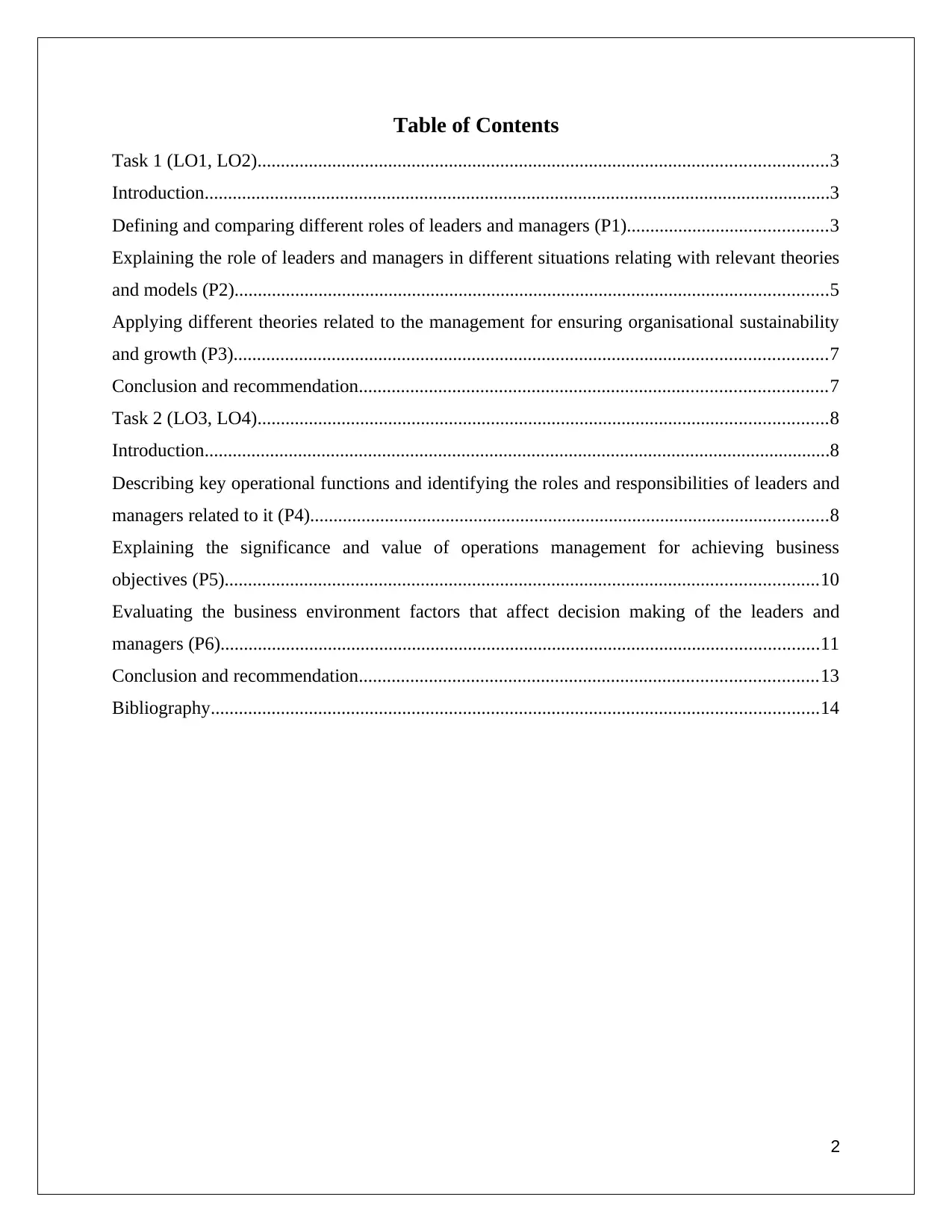
Table of Contents
Task 1 (LO1, LO2)..........................................................................................................................3
Introduction......................................................................................................................................3
Defining and comparing different roles of leaders and managers (P1)...........................................3
Explaining the role of leaders and managers in different situations relating with relevant theories
and models (P2)...............................................................................................................................5
Applying different theories related to the management for ensuring organisational sustainability
and growth (P3)...............................................................................................................................7
Conclusion and recommendation....................................................................................................7
Task 2 (LO3, LO4)..........................................................................................................................8
Introduction......................................................................................................................................8
Describing key operational functions and identifying the roles and responsibilities of leaders and
managers related to it (P4)...............................................................................................................8
Explaining the significance and value of operations management for achieving business
objectives (P5)...............................................................................................................................10
Evaluating the business environment factors that affect decision making of the leaders and
managers (P6)................................................................................................................................11
Conclusion and recommendation..................................................................................................13
Bibliography..................................................................................................................................14
2
Task 1 (LO1, LO2)..........................................................................................................................3
Introduction......................................................................................................................................3
Defining and comparing different roles of leaders and managers (P1)...........................................3
Explaining the role of leaders and managers in different situations relating with relevant theories
and models (P2)...............................................................................................................................5
Applying different theories related to the management for ensuring organisational sustainability
and growth (P3)...............................................................................................................................7
Conclusion and recommendation....................................................................................................7
Task 2 (LO3, LO4)..........................................................................................................................8
Introduction......................................................................................................................................8
Describing key operational functions and identifying the roles and responsibilities of leaders and
managers related to it (P4)...............................................................................................................8
Explaining the significance and value of operations management for achieving business
objectives (P5)...............................................................................................................................10
Evaluating the business environment factors that affect decision making of the leaders and
managers (P6)................................................................................................................................11
Conclusion and recommendation..................................................................................................13
Bibliography..................................................................................................................................14
2
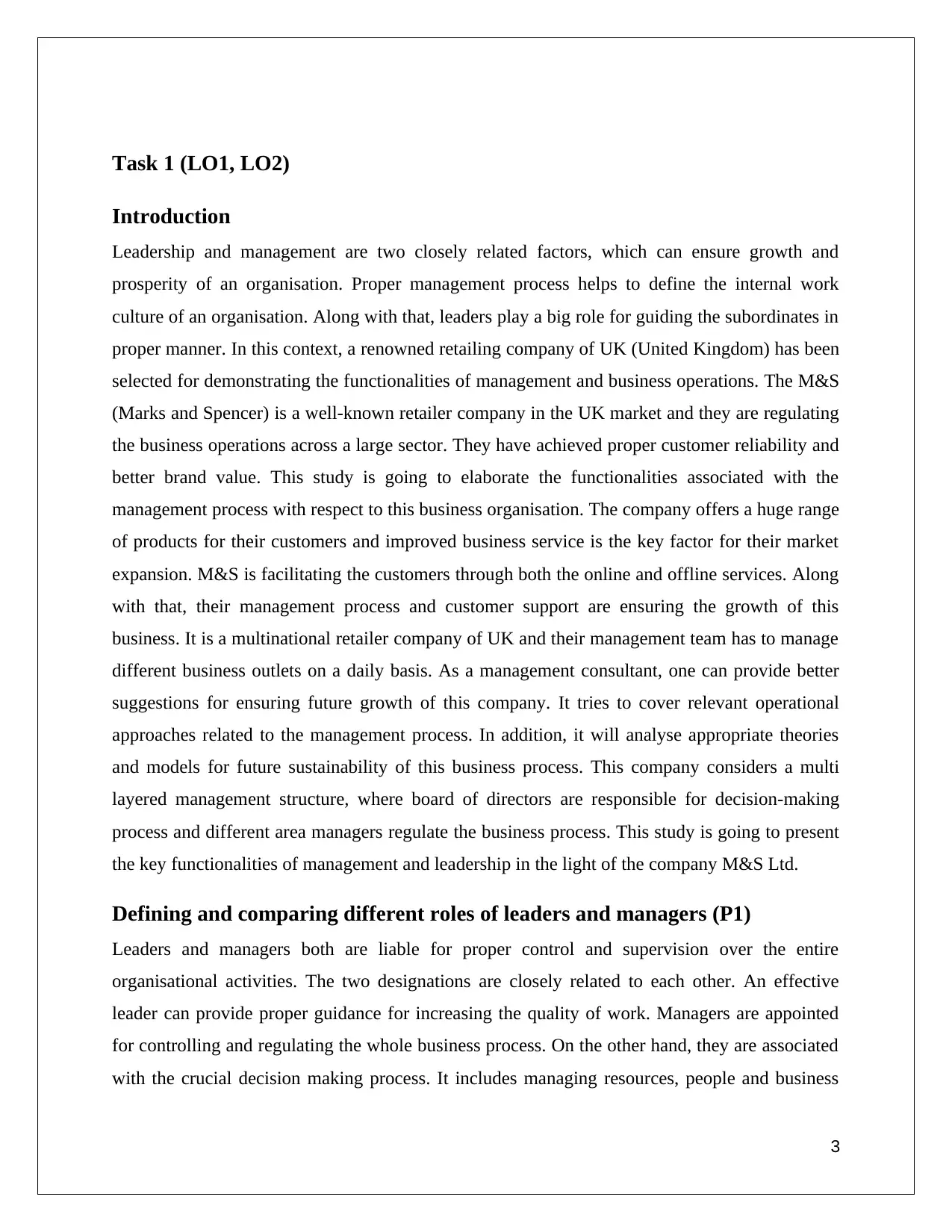
Task 1 (LO1, LO2)
Introduction
Leadership and management are two closely related factors, which can ensure growth and
prosperity of an organisation. Proper management process helps to define the internal work
culture of an organisation. Along with that, leaders play a big role for guiding the subordinates in
proper manner. In this context, a renowned retailing company of UK (United Kingdom) has been
selected for demonstrating the functionalities of management and business operations. The M&S
(Marks and Spencer) is a well-known retailer company in the UK market and they are regulating
the business operations across a large sector. They have achieved proper customer reliability and
better brand value. This study is going to elaborate the functionalities associated with the
management process with respect to this business organisation. The company offers a huge range
of products for their customers and improved business service is the key factor for their market
expansion. M&S is facilitating the customers through both the online and offline services. Along
with that, their management process and customer support are ensuring the growth of this
business. It is a multinational retailer company of UK and their management team has to manage
different business outlets on a daily basis. As a management consultant, one can provide better
suggestions for ensuring future growth of this company. It tries to cover relevant operational
approaches related to the management process. In addition, it will analyse appropriate theories
and models for future sustainability of this business process. This company considers a multi
layered management structure, where board of directors are responsible for decision-making
process and different area managers regulate the business process. This study is going to present
the key functionalities of management and leadership in the light of the company M&S Ltd.
Defining and comparing different roles of leaders and managers (P1)
Leaders and managers both are liable for proper control and supervision over the entire
organisational activities. The two designations are closely related to each other. An effective
leader can provide proper guidance for increasing the quality of work. Managers are appointed
for controlling and regulating the whole business process. On the other hand, they are associated
with the crucial decision making process. It includes managing resources, people and business
3
Introduction
Leadership and management are two closely related factors, which can ensure growth and
prosperity of an organisation. Proper management process helps to define the internal work
culture of an organisation. Along with that, leaders play a big role for guiding the subordinates in
proper manner. In this context, a renowned retailing company of UK (United Kingdom) has been
selected for demonstrating the functionalities of management and business operations. The M&S
(Marks and Spencer) is a well-known retailer company in the UK market and they are regulating
the business operations across a large sector. They have achieved proper customer reliability and
better brand value. This study is going to elaborate the functionalities associated with the
management process with respect to this business organisation. The company offers a huge range
of products for their customers and improved business service is the key factor for their market
expansion. M&S is facilitating the customers through both the online and offline services. Along
with that, their management process and customer support are ensuring the growth of this
business. It is a multinational retailer company of UK and their management team has to manage
different business outlets on a daily basis. As a management consultant, one can provide better
suggestions for ensuring future growth of this company. It tries to cover relevant operational
approaches related to the management process. In addition, it will analyse appropriate theories
and models for future sustainability of this business process. This company considers a multi
layered management structure, where board of directors are responsible for decision-making
process and different area managers regulate the business process. This study is going to present
the key functionalities of management and leadership in the light of the company M&S Ltd.
Defining and comparing different roles of leaders and managers (P1)
Leaders and managers both are liable for proper control and supervision over the entire
organisational activities. The two designations are closely related to each other. An effective
leader can provide proper guidance for increasing the quality of work. Managers are appointed
for controlling and regulating the whole business process. On the other hand, they are associated
with the crucial decision making process. It includes managing resources, people and business
3

regulation. A leader always tries to guide the subordinates for quality improvement. The
subordinates need to follow the leader for choosing right path and proper guidance. Therefore,
leaders lead the way with a team of subordinates. On the other hand, managers are intended
towards the fullest usage of resource. People are considered as human resource in an
organisational structure. Managers always want to make people work for them. It represents an
autocratic or a certain kind of dictatorship, where subordinates should follow the command of
the manager. Therefore, a good business owner needs to learn both the skills of leadership and
management. The roles and responsibilities of a leader is given below.
● Leader is required in every level of the organisation
● A leader could be proper representative of the organisation
● Integrating and harmonising personal and organisational goals
● Leader is responsible for providing good support
● Leader has to play the role of a friend, philosopher and guide
The roles and responsibilities of managers are given below.
● Maintaining proper business administration
● Regulating and monitoring daily business activities
● Maintaining better business integrity
● Effective decision making
● Measuring business growth
● Implementing proper business communication
● Staffing in the organisation
Effective management strategies also consider a better leadership as an important parameter. As
stated by Nahavandi (2016), effective leadership helps to ensure the future sustainability of a
business. The business organisation M&S Ltd has considered the effectiveness of leadership and
based on that their management structure represents proper hierarchy
(www.marksandspencer.com, 2017). They have accumulated many experienced persons in their
board of directors. In this huge business structure, many experienced people are required for
maintaining different business operations. Therefore, their board of directors considers chairman,
chief executive, chief finance officer, executive director of customer and many more. On the
other hand, they have considered the necessity of leadership in every business level. For that
4
subordinates need to follow the leader for choosing right path and proper guidance. Therefore,
leaders lead the way with a team of subordinates. On the other hand, managers are intended
towards the fullest usage of resource. People are considered as human resource in an
organisational structure. Managers always want to make people work for them. It represents an
autocratic or a certain kind of dictatorship, where subordinates should follow the command of
the manager. Therefore, a good business owner needs to learn both the skills of leadership and
management. The roles and responsibilities of a leader is given below.
● Leader is required in every level of the organisation
● A leader could be proper representative of the organisation
● Integrating and harmonising personal and organisational goals
● Leader is responsible for providing good support
● Leader has to play the role of a friend, philosopher and guide
The roles and responsibilities of managers are given below.
● Maintaining proper business administration
● Regulating and monitoring daily business activities
● Maintaining better business integrity
● Effective decision making
● Measuring business growth
● Implementing proper business communication
● Staffing in the organisation
Effective management strategies also consider a better leadership as an important parameter. As
stated by Nahavandi (2016), effective leadership helps to ensure the future sustainability of a
business. The business organisation M&S Ltd has considered the effectiveness of leadership and
based on that their management structure represents proper hierarchy
(www.marksandspencer.com, 2017). They have accumulated many experienced persons in their
board of directors. In this huge business structure, many experienced people are required for
maintaining different business operations. Therefore, their board of directors considers chairman,
chief executive, chief finance officer, executive director of customer and many more. On the
other hand, they have considered the necessity of leadership in every business level. For that
4
Secure Best Marks with AI Grader
Need help grading? Try our AI Grader for instant feedback on your assignments.

purpose, they have incorporated and implemented the qualities of leadership in every business
level.
Explaining the role of leaders and managers in different situations relating
with relevant theories and models (P2)
Both the leaders and managers are associated with the business regulation process. Their
operation strategies create great impact on the organisational activities. According to Goleman et
al. (2013), a leadership management process should consider the proposed objectives of an
organisation. Therefore, effective leadership management can ensure the future success and it is
helpful for achieving proposed business objectives. A manager and a leader need to handle
different critical situations within a business environment and their activities define entire
business regulation process. In this context, the effectiveness of leadership could be discussed
through relevant theories and models of leadership. Some contemporary theories of leadership
could be considered in this regard and they are behavioural, contingency, transactional leadership
and transformational theories of leadership.
The behavioural theory considers the approach of the leader through certain types of parameters
like physical, social and mental. It also gives emphasis on the preference of a leader with related
to work and people. As mentioned by Fairhurst and Connaughton (2014), the inborn qualities of
a person contribute a lot in the leadership management process.
As depicted by Johnston and Marshall (2016), contingency theory gives proper emphasis on the
situation based work process. This theory signifies that different situational contexts determine
the quality of a leadership. Moreover, the leadership process is based on different situational
elements.
The transactional leadership theory represents a beneficial relationship between the leader and
the followers. As mentioned by Tourish (2014), effective leaders should maintain proper
relationship with the subordinates. In this way, a healthy and positive work environment could be
maintained. This theory states that leaders should recognise the work of subordinates through
giving proper reward. On the other hand, proper feedback should be provided for an assigned
task. According to Beck and Cowan (2014), the transactional leadership theory enhances the
motivation level of the employees in a work culture.
5
level.
Explaining the role of leaders and managers in different situations relating
with relevant theories and models (P2)
Both the leaders and managers are associated with the business regulation process. Their
operation strategies create great impact on the organisational activities. According to Goleman et
al. (2013), a leadership management process should consider the proposed objectives of an
organisation. Therefore, effective leadership management can ensure the future success and it is
helpful for achieving proposed business objectives. A manager and a leader need to handle
different critical situations within a business environment and their activities define entire
business regulation process. In this context, the effectiveness of leadership could be discussed
through relevant theories and models of leadership. Some contemporary theories of leadership
could be considered in this regard and they are behavioural, contingency, transactional leadership
and transformational theories of leadership.
The behavioural theory considers the approach of the leader through certain types of parameters
like physical, social and mental. It also gives emphasis on the preference of a leader with related
to work and people. As mentioned by Fairhurst and Connaughton (2014), the inborn qualities of
a person contribute a lot in the leadership management process.
As depicted by Johnston and Marshall (2016), contingency theory gives proper emphasis on the
situation based work process. This theory signifies that different situational contexts determine
the quality of a leadership. Moreover, the leadership process is based on different situational
elements.
The transactional leadership theory represents a beneficial relationship between the leader and
the followers. As mentioned by Tourish (2014), effective leaders should maintain proper
relationship with the subordinates. In this way, a healthy and positive work environment could be
maintained. This theory states that leaders should recognise the work of subordinates through
giving proper reward. On the other hand, proper feedback should be provided for an assigned
task. According to Beck and Cowan (2014), the transactional leadership theory enhances the
motivation level of the employees in a work culture.
5

The transformational leadership theory considers the relationship management in a business
process. As stated by Renz (2016), effective communication process can enhance the relationship
in a business scenario. Therefore, leaders could involve with the subordinates and motivate them
towards the work culture. It helps to bring positive changes among the subordinates and that
could be possible through the inspirational nature of a leader.
In addition, the leadership styles play an important role in an organisational culture. Three types
of leadership types could be elaborated in this regard and they are autocratic, democratic and
laissez-faire. According to Boezeman and Ellemers (2014), democratic leadership style is
effective in an organisational structure. It provides better communication scopes with the other
organisational workers. In addition, important thoughts and ideas could be exchanges with each
other in this process. On the other hand, appropriate model is necessary in a leadership process.
It considers all the essential dimensions associated with a business management process.
The classical management theory considers an effective management strategy related to the
following factors of a business.
● Distribution of work
● Implementing authority
● Maintaining organisational discipline
● Command over regular activities
● Arranging proper remuneration package
● Recruiting deserving candidates
The company M&S Ltd. has implemented effective leadership structure, where subordinates can
provide proper feedback and ideas about daily work process. In addition, different area managers
have established proper relationship with their subordinates. The reporting section is responsible
for maintaining the record of daily business activity. Along with that, effective communication
process has been able to maintain proper business relationship with all stakeholders of the
business. The customer support team of M&S Ltd. is prepared for resolving the queries of the
customers and providing them better business service. Their effective business management
process is facilitating the service delivery process of this company. On the other hand, they are
intended towards the recognising the inner talents of the subordinates. Different work appraisals
and reward giving programs are enhancing the motivation level of the employees. Moreover,
their work culture is maintaining proper uniformity across all business units.
6
process. As stated by Renz (2016), effective communication process can enhance the relationship
in a business scenario. Therefore, leaders could involve with the subordinates and motivate them
towards the work culture. It helps to bring positive changes among the subordinates and that
could be possible through the inspirational nature of a leader.
In addition, the leadership styles play an important role in an organisational culture. Three types
of leadership types could be elaborated in this regard and they are autocratic, democratic and
laissez-faire. According to Boezeman and Ellemers (2014), democratic leadership style is
effective in an organisational structure. It provides better communication scopes with the other
organisational workers. In addition, important thoughts and ideas could be exchanges with each
other in this process. On the other hand, appropriate model is necessary in a leadership process.
It considers all the essential dimensions associated with a business management process.
The classical management theory considers an effective management strategy related to the
following factors of a business.
● Distribution of work
● Implementing authority
● Maintaining organisational discipline
● Command over regular activities
● Arranging proper remuneration package
● Recruiting deserving candidates
The company M&S Ltd. has implemented effective leadership structure, where subordinates can
provide proper feedback and ideas about daily work process. In addition, different area managers
have established proper relationship with their subordinates. The reporting section is responsible
for maintaining the record of daily business activity. Along with that, effective communication
process has been able to maintain proper business relationship with all stakeholders of the
business. The customer support team of M&S Ltd. is prepared for resolving the queries of the
customers and providing them better business service. Their effective business management
process is facilitating the service delivery process of this company. On the other hand, they are
intended towards the recognising the inner talents of the subordinates. Different work appraisals
and reward giving programs are enhancing the motivation level of the employees. Moreover,
their work culture is maintaining proper uniformity across all business units.
6
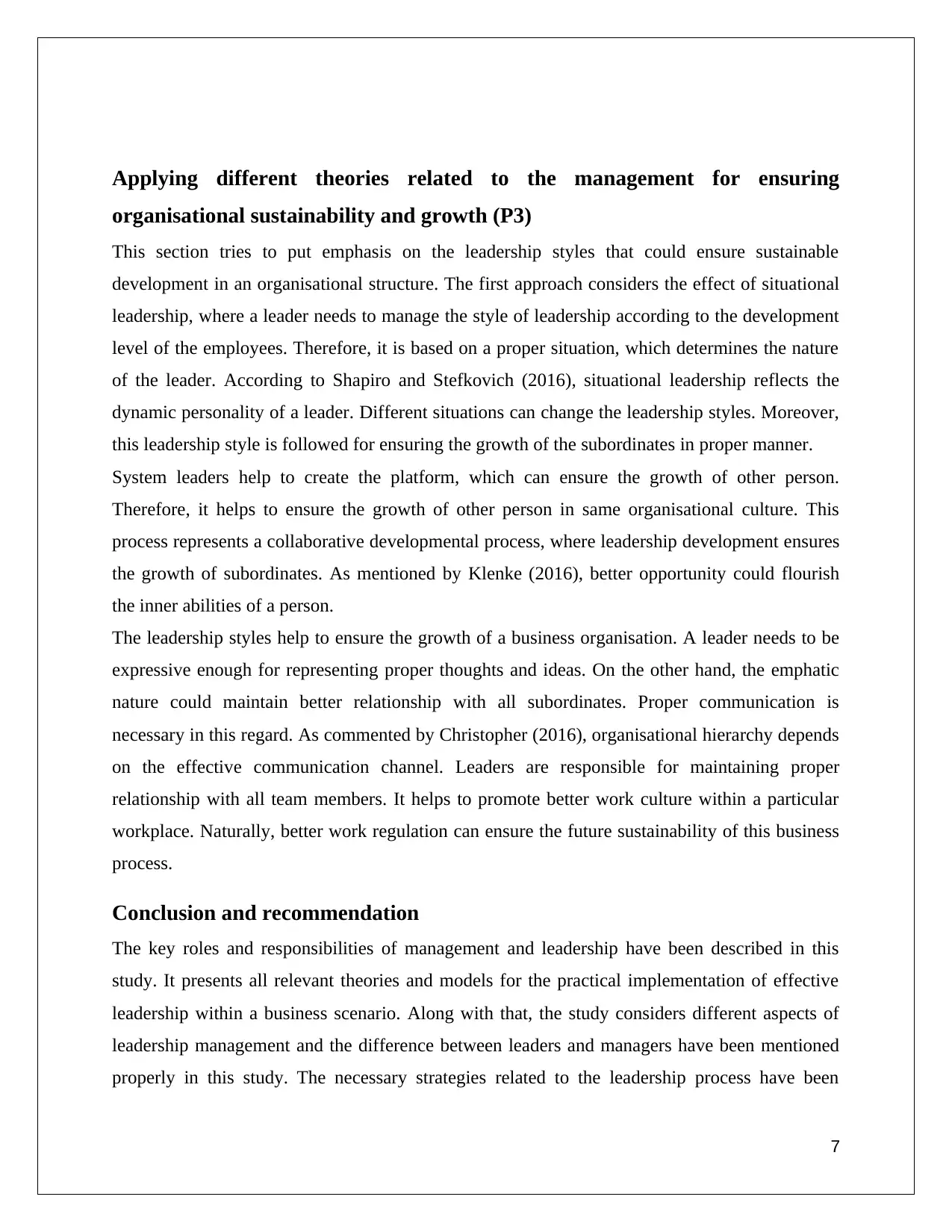
Applying different theories related to the management for ensuring
organisational sustainability and growth (P3)
This section tries to put emphasis on the leadership styles that could ensure sustainable
development in an organisational structure. The first approach considers the effect of situational
leadership, where a leader needs to manage the style of leadership according to the development
level of the employees. Therefore, it is based on a proper situation, which determines the nature
of the leader. According to Shapiro and Stefkovich (2016), situational leadership reflects the
dynamic personality of a leader. Different situations can change the leadership styles. Moreover,
this leadership style is followed for ensuring the growth of the subordinates in proper manner.
System leaders help to create the platform, which can ensure the growth of other person.
Therefore, it helps to ensure the growth of other person in same organisational culture. This
process represents a collaborative developmental process, where leadership development ensures
the growth of subordinates. As mentioned by Klenke (2016), better opportunity could flourish
the inner abilities of a person.
The leadership styles help to ensure the growth of a business organisation. A leader needs to be
expressive enough for representing proper thoughts and ideas. On the other hand, the emphatic
nature could maintain better relationship with all subordinates. Proper communication is
necessary in this regard. As commented by Christopher (2016), organisational hierarchy depends
on the effective communication channel. Leaders are responsible for maintaining proper
relationship with all team members. It helps to promote better work culture within a particular
workplace. Naturally, better work regulation can ensure the future sustainability of this business
process.
Conclusion and recommendation
The key roles and responsibilities of management and leadership have been described in this
study. It presents all relevant theories and models for the practical implementation of effective
leadership within a business scenario. Along with that, the study considers different aspects of
leadership management and the difference between leaders and managers have been mentioned
properly in this study. The necessary strategies related to the leadership process have been
7
organisational sustainability and growth (P3)
This section tries to put emphasis on the leadership styles that could ensure sustainable
development in an organisational structure. The first approach considers the effect of situational
leadership, where a leader needs to manage the style of leadership according to the development
level of the employees. Therefore, it is based on a proper situation, which determines the nature
of the leader. According to Shapiro and Stefkovich (2016), situational leadership reflects the
dynamic personality of a leader. Different situations can change the leadership styles. Moreover,
this leadership style is followed for ensuring the growth of the subordinates in proper manner.
System leaders help to create the platform, which can ensure the growth of other person.
Therefore, it helps to ensure the growth of other person in same organisational culture. This
process represents a collaborative developmental process, where leadership development ensures
the growth of subordinates. As mentioned by Klenke (2016), better opportunity could flourish
the inner abilities of a person.
The leadership styles help to ensure the growth of a business organisation. A leader needs to be
expressive enough for representing proper thoughts and ideas. On the other hand, the emphatic
nature could maintain better relationship with all subordinates. Proper communication is
necessary in this regard. As commented by Christopher (2016), organisational hierarchy depends
on the effective communication channel. Leaders are responsible for maintaining proper
relationship with all team members. It helps to promote better work culture within a particular
workplace. Naturally, better work regulation can ensure the future sustainability of this business
process.
Conclusion and recommendation
The key roles and responsibilities of management and leadership have been described in this
study. It presents all relevant theories and models for the practical implementation of effective
leadership within a business scenario. Along with that, the study considers different aspects of
leadership management and the difference between leaders and managers have been mentioned
properly in this study. The necessary strategies related to the leadership process have been
7
Paraphrase This Document
Need a fresh take? Get an instant paraphrase of this document with our AI Paraphraser
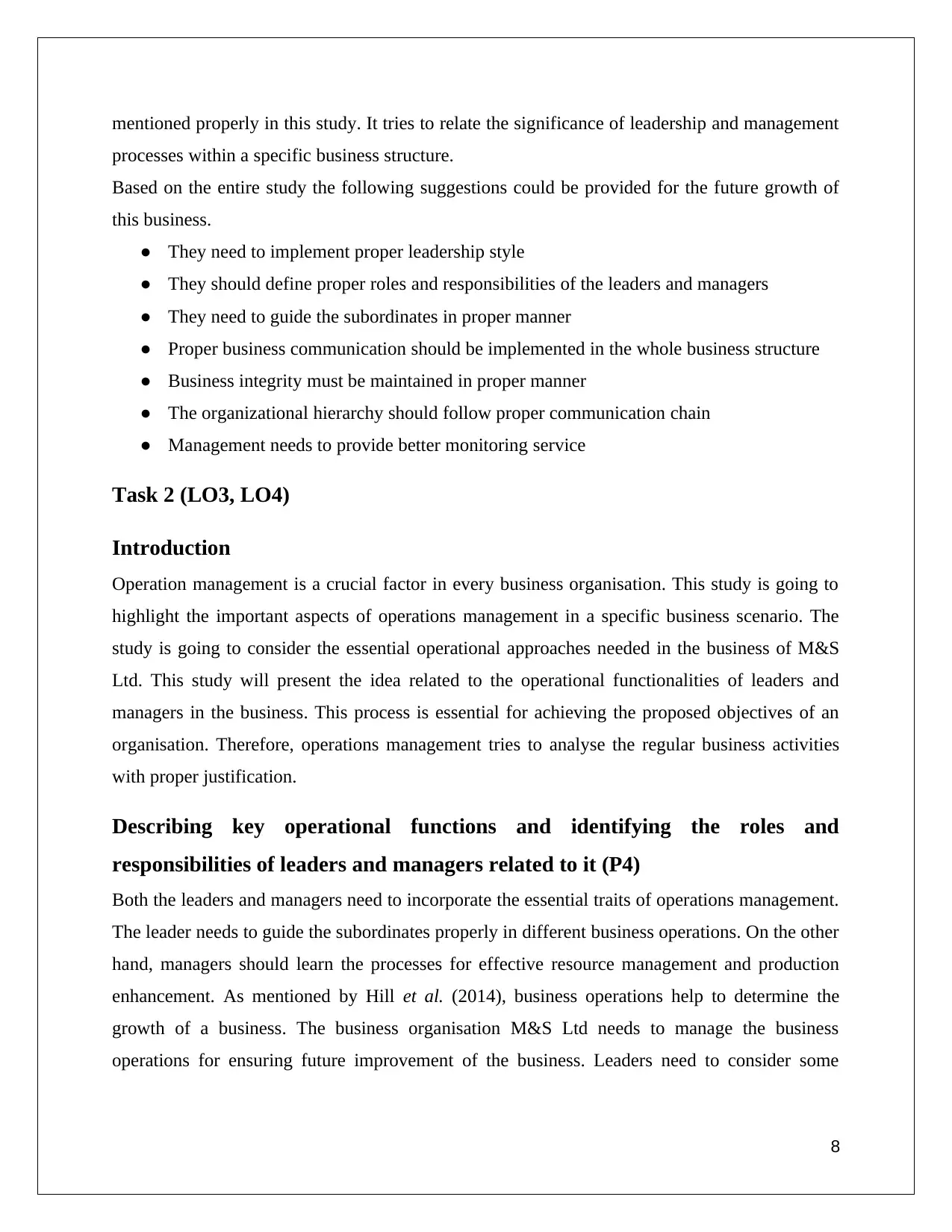
mentioned properly in this study. It tries to relate the significance of leadership and management
processes within a specific business structure.
Based on the entire study the following suggestions could be provided for the future growth of
this business.
● They need to implement proper leadership style
● They should define proper roles and responsibilities of the leaders and managers
● They need to guide the subordinates in proper manner
● Proper business communication should be implemented in the whole business structure
● Business integrity must be maintained in proper manner
● The organizational hierarchy should follow proper communication chain
● Management needs to provide better monitoring service
Task 2 (LO3, LO4)
Introduction
Operation management is a crucial factor in every business organisation. This study is going to
highlight the important aspects of operations management in a specific business scenario. The
study is going to consider the essential operational approaches needed in the business of M&S
Ltd. This study will present the idea related to the operational functionalities of leaders and
managers in the business. This process is essential for achieving the proposed objectives of an
organisation. Therefore, operations management tries to analyse the regular business activities
with proper justification.
Describing key operational functions and identifying the roles and
responsibilities of leaders and managers related to it (P4)
Both the leaders and managers need to incorporate the essential traits of operations management.
The leader needs to guide the subordinates properly in different business operations. On the other
hand, managers should learn the processes for effective resource management and production
enhancement. As mentioned by Hill et al. (2014), business operations help to determine the
growth of a business. The business organisation M&S Ltd needs to manage the business
operations for ensuring future improvement of the business. Leaders need to consider some
8
processes within a specific business structure.
Based on the entire study the following suggestions could be provided for the future growth of
this business.
● They need to implement proper leadership style
● They should define proper roles and responsibilities of the leaders and managers
● They need to guide the subordinates in proper manner
● Proper business communication should be implemented in the whole business structure
● Business integrity must be maintained in proper manner
● The organizational hierarchy should follow proper communication chain
● Management needs to provide better monitoring service
Task 2 (LO3, LO4)
Introduction
Operation management is a crucial factor in every business organisation. This study is going to
highlight the important aspects of operations management in a specific business scenario. The
study is going to consider the essential operational approaches needed in the business of M&S
Ltd. This study will present the idea related to the operational functionalities of leaders and
managers in the business. This process is essential for achieving the proposed objectives of an
organisation. Therefore, operations management tries to analyse the regular business activities
with proper justification.
Describing key operational functions and identifying the roles and
responsibilities of leaders and managers related to it (P4)
Both the leaders and managers need to incorporate the essential traits of operations management.
The leader needs to guide the subordinates properly in different business operations. On the other
hand, managers should learn the processes for effective resource management and production
enhancement. As mentioned by Hill et al. (2014), business operations help to determine the
growth of a business. The business organisation M&S Ltd needs to manage the business
operations for ensuring future improvement of the business. Leaders need to consider some
8
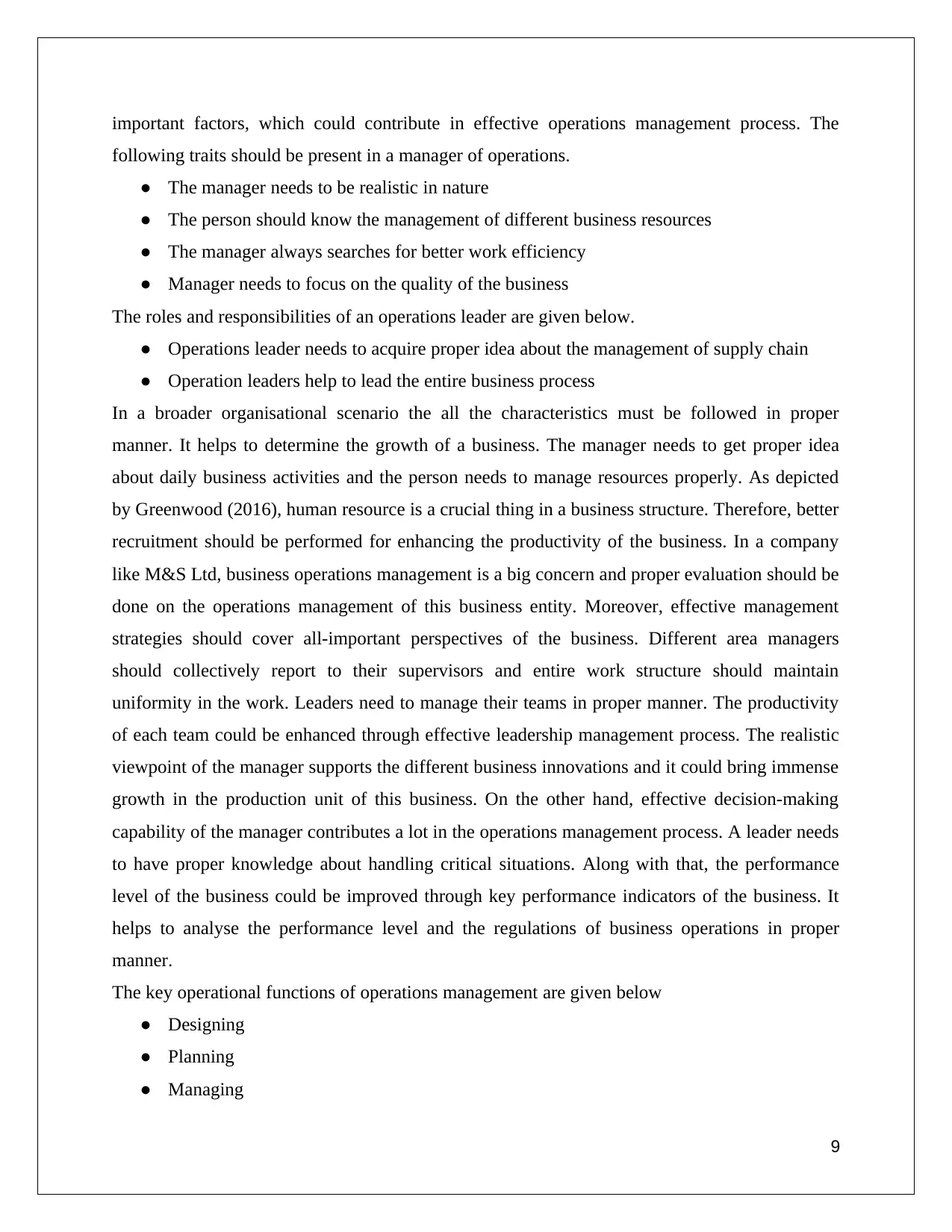
important factors, which could contribute in effective operations management process. The
following traits should be present in a manager of operations.
● The manager needs to be realistic in nature
● The person should know the management of different business resources
● The manager always searches for better work efficiency
● Manager needs to focus on the quality of the business
The roles and responsibilities of an operations leader are given below.
● Operations leader needs to acquire proper idea about the management of supply chain
● Operation leaders help to lead the entire business process
In a broader organisational scenario the all the characteristics must be followed in proper
manner. It helps to determine the growth of a business. The manager needs to get proper idea
about daily business activities and the person needs to manage resources properly. As depicted
by Greenwood (2016), human resource is a crucial thing in a business structure. Therefore, better
recruitment should be performed for enhancing the productivity of the business. In a company
like M&S Ltd, business operations management is a big concern and proper evaluation should be
done on the operations management of this business entity. Moreover, effective management
strategies should cover all-important perspectives of the business. Different area managers
should collectively report to their supervisors and entire work structure should maintain
uniformity in the work. Leaders need to manage their teams in proper manner. The productivity
of each team could be enhanced through effective leadership management process. The realistic
viewpoint of the manager supports the different business innovations and it could bring immense
growth in the production unit of this business. On the other hand, effective decision-making
capability of the manager contributes a lot in the operations management process. A leader needs
to have proper knowledge about handling critical situations. Along with that, the performance
level of the business could be improved through key performance indicators of the business. It
helps to analyse the performance level and the regulations of business operations in proper
manner.
The key operational functions of operations management are given below
● Designing
● Planning
● Managing
9
following traits should be present in a manager of operations.
● The manager needs to be realistic in nature
● The person should know the management of different business resources
● The manager always searches for better work efficiency
● Manager needs to focus on the quality of the business
The roles and responsibilities of an operations leader are given below.
● Operations leader needs to acquire proper idea about the management of supply chain
● Operation leaders help to lead the entire business process
In a broader organisational scenario the all the characteristics must be followed in proper
manner. It helps to determine the growth of a business. The manager needs to get proper idea
about daily business activities and the person needs to manage resources properly. As depicted
by Greenwood (2016), human resource is a crucial thing in a business structure. Therefore, better
recruitment should be performed for enhancing the productivity of the business. In a company
like M&S Ltd, business operations management is a big concern and proper evaluation should be
done on the operations management of this business entity. Moreover, effective management
strategies should cover all-important perspectives of the business. Different area managers
should collectively report to their supervisors and entire work structure should maintain
uniformity in the work. Leaders need to manage their teams in proper manner. The productivity
of each team could be enhanced through effective leadership management process. The realistic
viewpoint of the manager supports the different business innovations and it could bring immense
growth in the production unit of this business. On the other hand, effective decision-making
capability of the manager contributes a lot in the operations management process. A leader needs
to have proper knowledge about handling critical situations. Along with that, the performance
level of the business could be improved through key performance indicators of the business. It
helps to analyse the performance level and the regulations of business operations in proper
manner.
The key operational functions of operations management are given below
● Designing
● Planning
● Managing
9
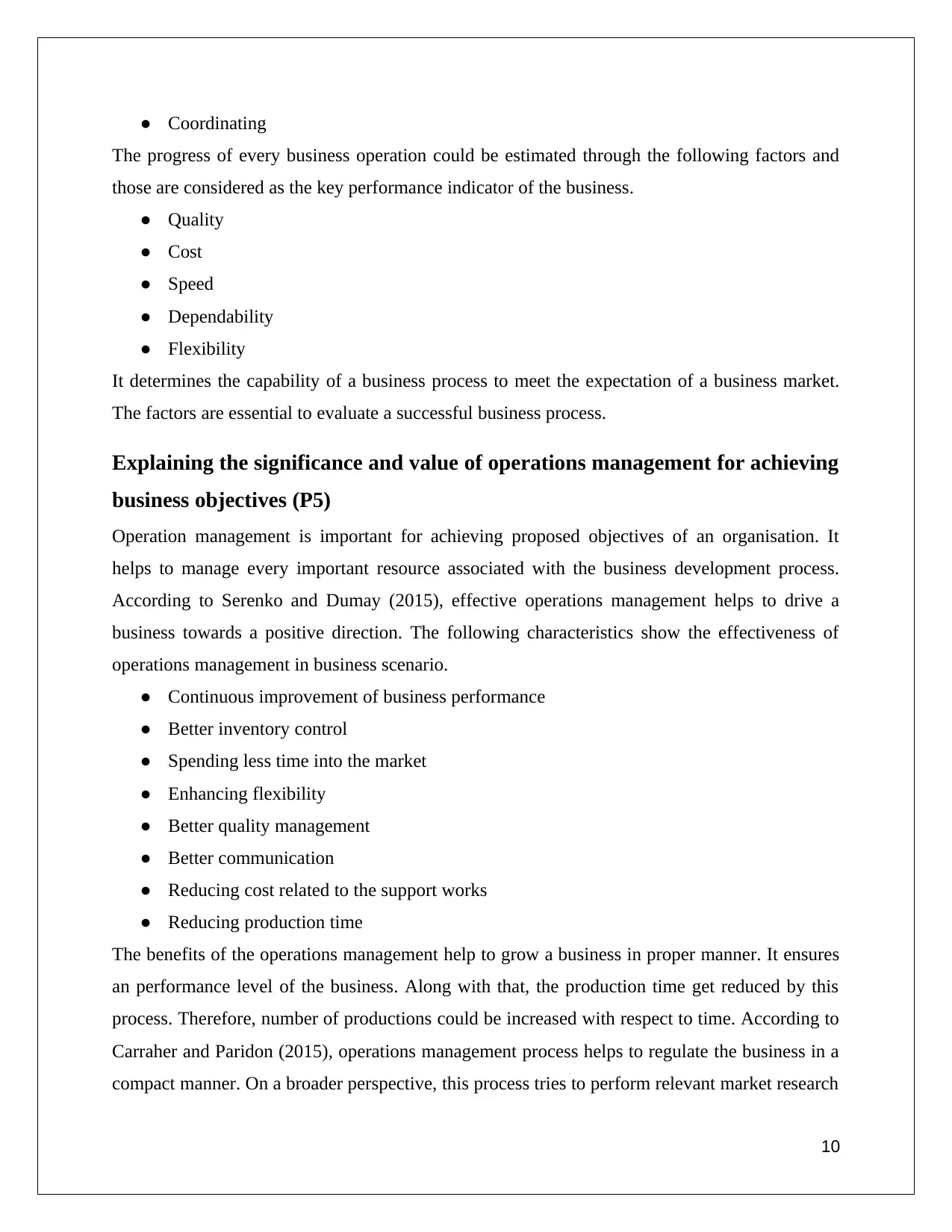
● Coordinating
The progress of every business operation could be estimated through the following factors and
those are considered as the key performance indicator of the business.
● Quality
● Cost
● Speed
● Dependability
● Flexibility
It determines the capability of a business process to meet the expectation of a business market.
The factors are essential to evaluate a successful business process.
Explaining the significance and value of operations management for achieving
business objectives (P5)
Operation management is important for achieving proposed objectives of an organisation. It
helps to manage every important resource associated with the business development process.
According to Serenko and Dumay (2015), effective operations management helps to drive a
business towards a positive direction. The following characteristics show the effectiveness of
operations management in business scenario.
● Continuous improvement of business performance
● Better inventory control
● Spending less time into the market
● Enhancing flexibility
● Better quality management
● Better communication
● Reducing cost related to the support works
● Reducing production time
The benefits of the operations management help to grow a business in proper manner. It ensures
an performance level of the business. Along with that, the production time get reduced by this
process. Therefore, number of productions could be increased with respect to time. According to
Carraher and Paridon (2015), operations management process helps to regulate the business in a
compact manner. On a broader perspective, this process tries to perform relevant market research
10
The progress of every business operation could be estimated through the following factors and
those are considered as the key performance indicator of the business.
● Quality
● Cost
● Speed
● Dependability
● Flexibility
It determines the capability of a business process to meet the expectation of a business market.
The factors are essential to evaluate a successful business process.
Explaining the significance and value of operations management for achieving
business objectives (P5)
Operation management is important for achieving proposed objectives of an organisation. It
helps to manage every important resource associated with the business development process.
According to Serenko and Dumay (2015), effective operations management helps to drive a
business towards a positive direction. The following characteristics show the effectiveness of
operations management in business scenario.
● Continuous improvement of business performance
● Better inventory control
● Spending less time into the market
● Enhancing flexibility
● Better quality management
● Better communication
● Reducing cost related to the support works
● Reducing production time
The benefits of the operations management help to grow a business in proper manner. It ensures
an performance level of the business. Along with that, the production time get reduced by this
process. Therefore, number of productions could be increased with respect to time. According to
Carraher and Paridon (2015), operations management process helps to regulate the business in a
compact manner. On a broader perspective, this process tries to perform relevant market research
10
Secure Best Marks with AI Grader
Need help grading? Try our AI Grader for instant feedback on your assignments.
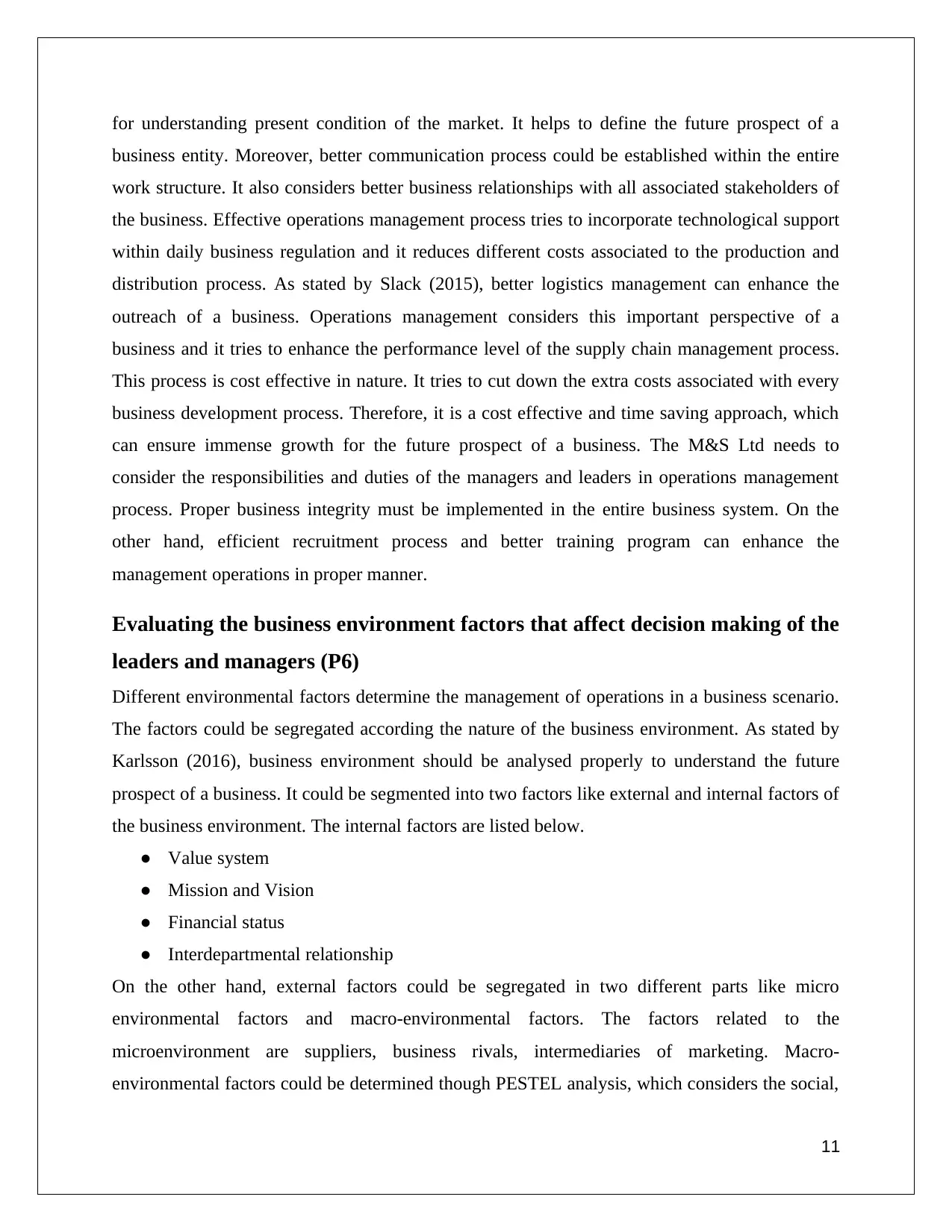
for understanding present condition of the market. It helps to define the future prospect of a
business entity. Moreover, better communication process could be established within the entire
work structure. It also considers better business relationships with all associated stakeholders of
the business. Effective operations management process tries to incorporate technological support
within daily business regulation and it reduces different costs associated to the production and
distribution process. As stated by Slack (2015), better logistics management can enhance the
outreach of a business. Operations management considers this important perspective of a
business and it tries to enhance the performance level of the supply chain management process.
This process is cost effective in nature. It tries to cut down the extra costs associated with every
business development process. Therefore, it is a cost effective and time saving approach, which
can ensure immense growth for the future prospect of a business. The M&S Ltd needs to
consider the responsibilities and duties of the managers and leaders in operations management
process. Proper business integrity must be implemented in the entire business system. On the
other hand, efficient recruitment process and better training program can enhance the
management operations in proper manner.
Evaluating the business environment factors that affect decision making of the
leaders and managers (P6)
Different environmental factors determine the management of operations in a business scenario.
The factors could be segregated according the nature of the business environment. As stated by
Karlsson (2016), business environment should be analysed properly to understand the future
prospect of a business. It could be segmented into two factors like external and internal factors of
the business environment. The internal factors are listed below.
● Value system
● Mission and Vision
● Financial status
● Interdepartmental relationship
On the other hand, external factors could be segregated in two different parts like micro
environmental factors and macro-environmental factors. The factors related to the
microenvironment are suppliers, business rivals, intermediaries of marketing. Macro-
environmental factors could be determined though PESTEL analysis, which considers the social,
11
business entity. Moreover, better communication process could be established within the entire
work structure. It also considers better business relationships with all associated stakeholders of
the business. Effective operations management process tries to incorporate technological support
within daily business regulation and it reduces different costs associated to the production and
distribution process. As stated by Slack (2015), better logistics management can enhance the
outreach of a business. Operations management considers this important perspective of a
business and it tries to enhance the performance level of the supply chain management process.
This process is cost effective in nature. It tries to cut down the extra costs associated with every
business development process. Therefore, it is a cost effective and time saving approach, which
can ensure immense growth for the future prospect of a business. The M&S Ltd needs to
consider the responsibilities and duties of the managers and leaders in operations management
process. Proper business integrity must be implemented in the entire business system. On the
other hand, efficient recruitment process and better training program can enhance the
management operations in proper manner.
Evaluating the business environment factors that affect decision making of the
leaders and managers (P6)
Different environmental factors determine the management of operations in a business scenario.
The factors could be segregated according the nature of the business environment. As stated by
Karlsson (2016), business environment should be analysed properly to understand the future
prospect of a business. It could be segmented into two factors like external and internal factors of
the business environment. The internal factors are listed below.
● Value system
● Mission and Vision
● Financial status
● Interdepartmental relationship
On the other hand, external factors could be segregated in two different parts like micro
environmental factors and macro-environmental factors. The factors related to the
microenvironment are suppliers, business rivals, intermediaries of marketing. Macro-
environmental factors could be determined though PESTEL analysis, which considers the social,
11
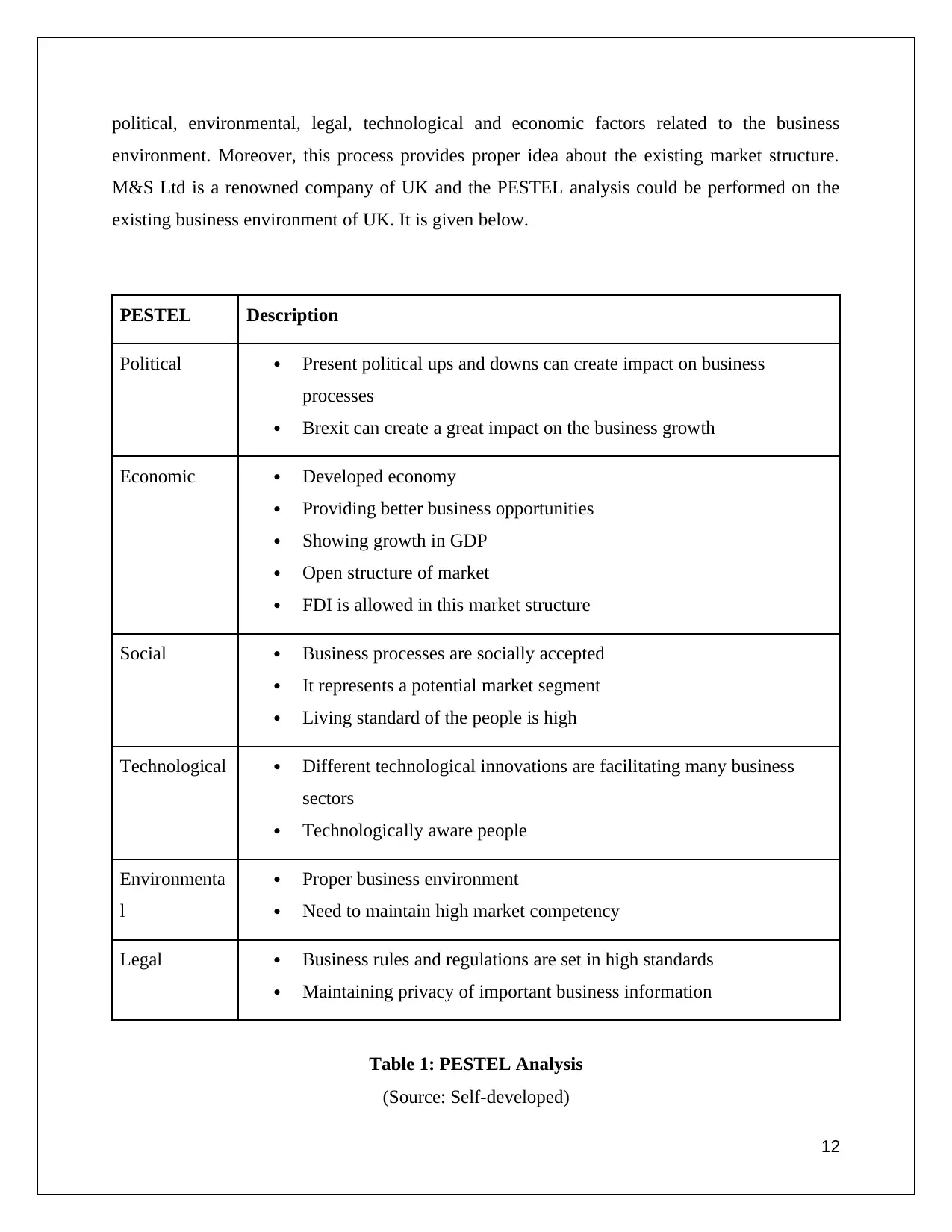
political, environmental, legal, technological and economic factors related to the business
environment. Moreover, this process provides proper idea about the existing market structure.
M&S Ltd is a renowned company of UK and the PESTEL analysis could be performed on the
existing business environment of UK. It is given below.
PESTEL Description
Political Present political ups and downs can create impact on business
processes
Brexit can create a great impact on the business growth
Economic Developed economy
Providing better business opportunities
Showing growth in GDP
Open structure of market
FDI is allowed in this market structure
Social Business processes are socially accepted
It represents a potential market segment
Living standard of the people is high
Technological Different technological innovations are facilitating many business
sectors
Technologically aware people
Environmenta
l
Proper business environment
Need to maintain high market competency
Legal Business rules and regulations are set in high standards
Maintaining privacy of important business information
Table 1: PESTEL Analysis
(Source: Self-developed)
12
environment. Moreover, this process provides proper idea about the existing market structure.
M&S Ltd is a renowned company of UK and the PESTEL analysis could be performed on the
existing business environment of UK. It is given below.
PESTEL Description
Political Present political ups and downs can create impact on business
processes
Brexit can create a great impact on the business growth
Economic Developed economy
Providing better business opportunities
Showing growth in GDP
Open structure of market
FDI is allowed in this market structure
Social Business processes are socially accepted
It represents a potential market segment
Living standard of the people is high
Technological Different technological innovations are facilitating many business
sectors
Technologically aware people
Environmenta
l
Proper business environment
Need to maintain high market competency
Legal Business rules and regulations are set in high standards
Maintaining privacy of important business information
Table 1: PESTEL Analysis
(Source: Self-developed)
12
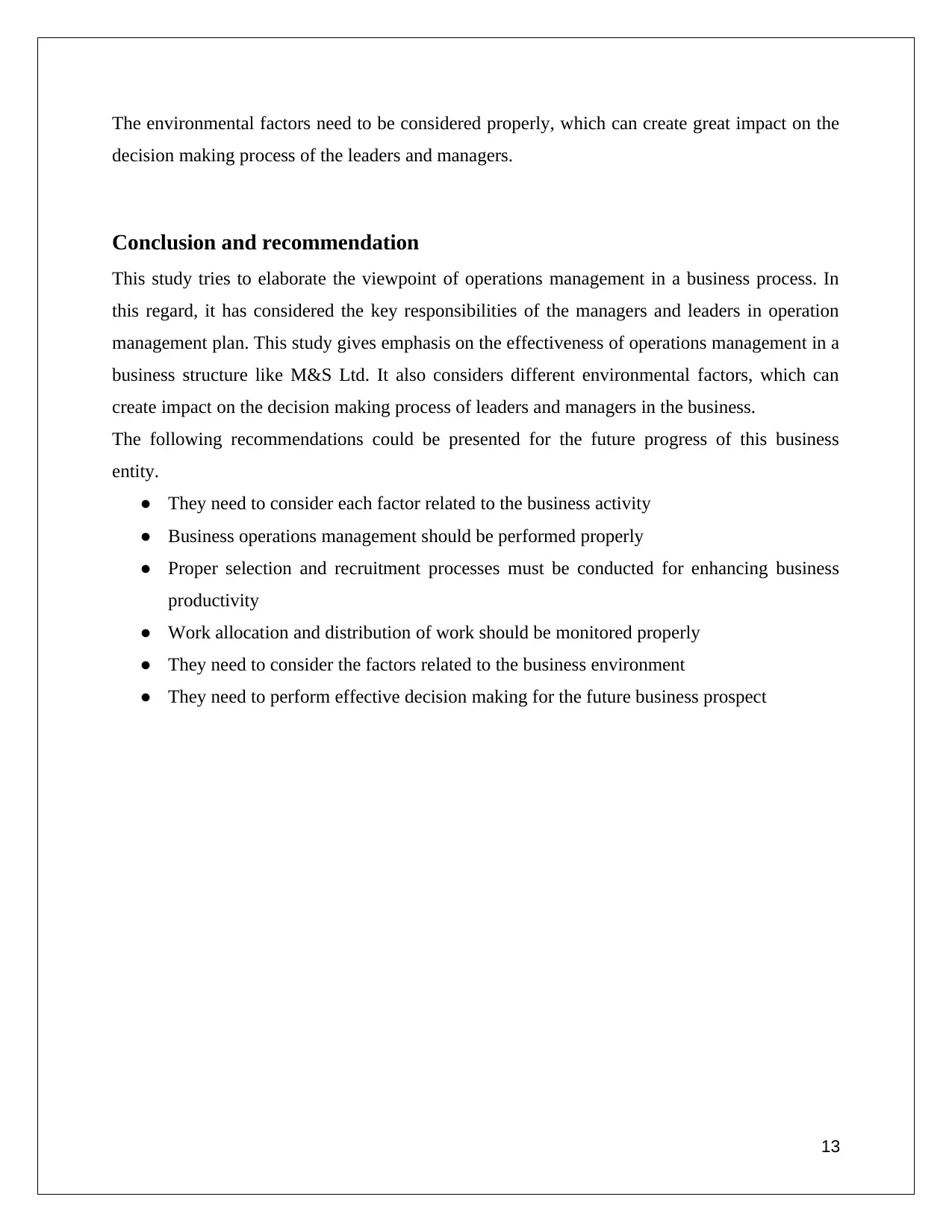
The environmental factors need to be considered properly, which can create great impact on the
decision making process of the leaders and managers.
Conclusion and recommendation
This study tries to elaborate the viewpoint of operations management in a business process. In
this regard, it has considered the key responsibilities of the managers and leaders in operation
management plan. This study gives emphasis on the effectiveness of operations management in a
business structure like M&S Ltd. It also considers different environmental factors, which can
create impact on the decision making process of leaders and managers in the business.
The following recommendations could be presented for the future progress of this business
entity.
● They need to consider each factor related to the business activity
● Business operations management should be performed properly
● Proper selection and recruitment processes must be conducted for enhancing business
productivity
● Work allocation and distribution of work should be monitored properly
● They need to consider the factors related to the business environment
● They need to perform effective decision making for the future business prospect
13
decision making process of the leaders and managers.
Conclusion and recommendation
This study tries to elaborate the viewpoint of operations management in a business process. In
this regard, it has considered the key responsibilities of the managers and leaders in operation
management plan. This study gives emphasis on the effectiveness of operations management in a
business structure like M&S Ltd. It also considers different environmental factors, which can
create impact on the decision making process of leaders and managers in the business.
The following recommendations could be presented for the future progress of this business
entity.
● They need to consider each factor related to the business activity
● Business operations management should be performed properly
● Proper selection and recruitment processes must be conducted for enhancing business
productivity
● Work allocation and distribution of work should be monitored properly
● They need to consider the factors related to the business environment
● They need to perform effective decision making for the future business prospect
13
Paraphrase This Document
Need a fresh take? Get an instant paraphrase of this document with our AI Paraphraser
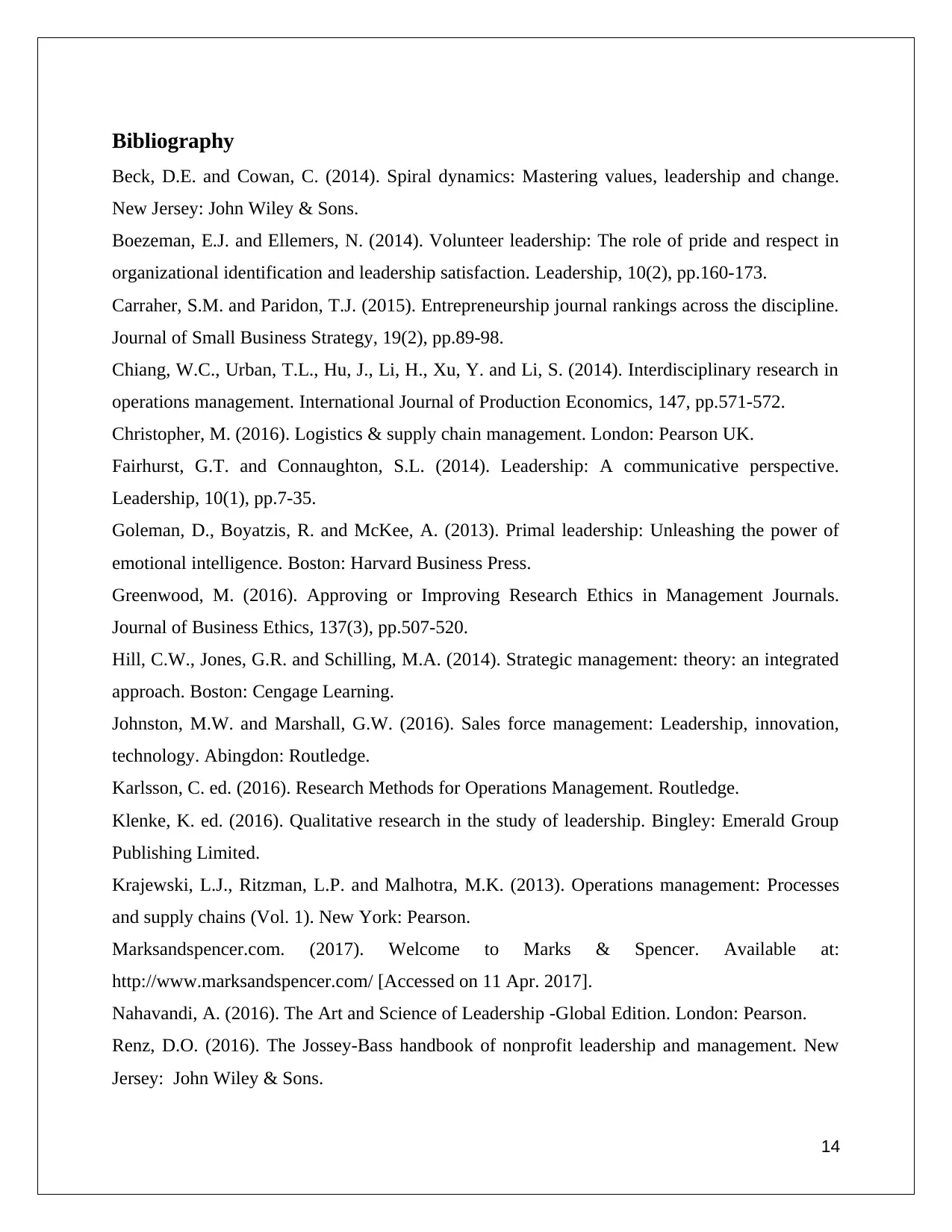
Bibliography
Beck, D.E. and Cowan, C. (2014). Spiral dynamics: Mastering values, leadership and change.
New Jersey: John Wiley & Sons.
Boezeman, E.J. and Ellemers, N. (2014). Volunteer leadership: The role of pride and respect in
organizational identification and leadership satisfaction. Leadership, 10(2), pp.160-173.
Carraher, S.M. and Paridon, T.J. (2015). Entrepreneurship journal rankings across the discipline.
Journal of Small Business Strategy, 19(2), pp.89-98.
Chiang, W.C., Urban, T.L., Hu, J., Li, H., Xu, Y. and Li, S. (2014). Interdisciplinary research in
operations management. International Journal of Production Economics, 147, pp.571-572.
Christopher, M. (2016). Logistics & supply chain management. London: Pearson UK.
Fairhurst, G.T. and Connaughton, S.L. (2014). Leadership: A communicative perspective.
Leadership, 10(1), pp.7-35.
Goleman, D., Boyatzis, R. and McKee, A. (2013). Primal leadership: Unleashing the power of
emotional intelligence. Boston: Harvard Business Press.
Greenwood, M. (2016). Approving or Improving Research Ethics in Management Journals.
Journal of Business Ethics, 137(3), pp.507-520.
Hill, C.W., Jones, G.R. and Schilling, M.A. (2014). Strategic management: theory: an integrated
approach. Boston: Cengage Learning.
Johnston, M.W. and Marshall, G.W. (2016). Sales force management: Leadership, innovation,
technology. Abingdon: Routledge.
Karlsson, C. ed. (2016). Research Methods for Operations Management. Routledge.
Klenke, K. ed. (2016). Qualitative research in the study of leadership. Bingley: Emerald Group
Publishing Limited.
Krajewski, L.J., Ritzman, L.P. and Malhotra, M.K. (2013). Operations management: Processes
and supply chains (Vol. 1). New York: Pearson.
Marksandspencer.com. (2017). Welcome to Marks & Spencer. Available at:
http://www.marksandspencer.com/ [Accessed on 11 Apr. 2017].
Nahavandi, A. (2016). The Art and Science of Leadership -Global Edition. London: Pearson.
Renz, D.O. (2016). The Jossey-Bass handbook of nonprofit leadership and management. New
Jersey: John Wiley & Sons.
14
Beck, D.E. and Cowan, C. (2014). Spiral dynamics: Mastering values, leadership and change.
New Jersey: John Wiley & Sons.
Boezeman, E.J. and Ellemers, N. (2014). Volunteer leadership: The role of pride and respect in
organizational identification and leadership satisfaction. Leadership, 10(2), pp.160-173.
Carraher, S.M. and Paridon, T.J. (2015). Entrepreneurship journal rankings across the discipline.
Journal of Small Business Strategy, 19(2), pp.89-98.
Chiang, W.C., Urban, T.L., Hu, J., Li, H., Xu, Y. and Li, S. (2014). Interdisciplinary research in
operations management. International Journal of Production Economics, 147, pp.571-572.
Christopher, M. (2016). Logistics & supply chain management. London: Pearson UK.
Fairhurst, G.T. and Connaughton, S.L. (2014). Leadership: A communicative perspective.
Leadership, 10(1), pp.7-35.
Goleman, D., Boyatzis, R. and McKee, A. (2013). Primal leadership: Unleashing the power of
emotional intelligence. Boston: Harvard Business Press.
Greenwood, M. (2016). Approving or Improving Research Ethics in Management Journals.
Journal of Business Ethics, 137(3), pp.507-520.
Hill, C.W., Jones, G.R. and Schilling, M.A. (2014). Strategic management: theory: an integrated
approach. Boston: Cengage Learning.
Johnston, M.W. and Marshall, G.W. (2016). Sales force management: Leadership, innovation,
technology. Abingdon: Routledge.
Karlsson, C. ed. (2016). Research Methods for Operations Management. Routledge.
Klenke, K. ed. (2016). Qualitative research in the study of leadership. Bingley: Emerald Group
Publishing Limited.
Krajewski, L.J., Ritzman, L.P. and Malhotra, M.K. (2013). Operations management: Processes
and supply chains (Vol. 1). New York: Pearson.
Marksandspencer.com. (2017). Welcome to Marks & Spencer. Available at:
http://www.marksandspencer.com/ [Accessed on 11 Apr. 2017].
Nahavandi, A. (2016). The Art and Science of Leadership -Global Edition. London: Pearson.
Renz, D.O. (2016). The Jossey-Bass handbook of nonprofit leadership and management. New
Jersey: John Wiley & Sons.
14
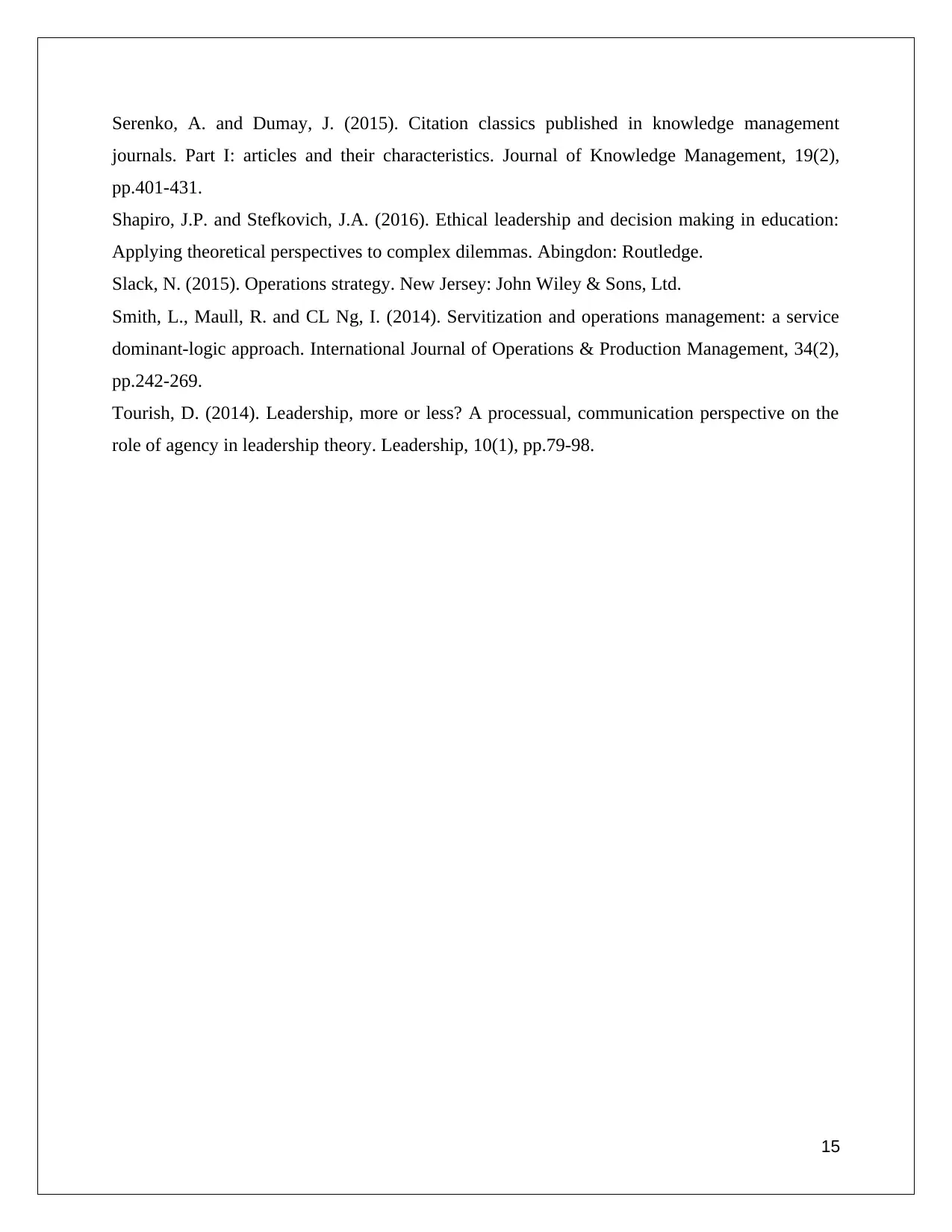
Serenko, A. and Dumay, J. (2015). Citation classics published in knowledge management
journals. Part I: articles and their characteristics. Journal of Knowledge Management, 19(2),
pp.401-431.
Shapiro, J.P. and Stefkovich, J.A. (2016). Ethical leadership and decision making in education:
Applying theoretical perspectives to complex dilemmas. Abingdon: Routledge.
Slack, N. (2015). Operations strategy. New Jersey: John Wiley & Sons, Ltd.
Smith, L., Maull, R. and CL Ng, I. (2014). Servitization and operations management: a service
dominant-logic approach. International Journal of Operations & Production Management, 34(2),
pp.242-269.
Tourish, D. (2014). Leadership, more or less? A processual, communication perspective on the
role of agency in leadership theory. Leadership, 10(1), pp.79-98.
15
journals. Part I: articles and their characteristics. Journal of Knowledge Management, 19(2),
pp.401-431.
Shapiro, J.P. and Stefkovich, J.A. (2016). Ethical leadership and decision making in education:
Applying theoretical perspectives to complex dilemmas. Abingdon: Routledge.
Slack, N. (2015). Operations strategy. New Jersey: John Wiley & Sons, Ltd.
Smith, L., Maull, R. and CL Ng, I. (2014). Servitization and operations management: a service
dominant-logic approach. International Journal of Operations & Production Management, 34(2),
pp.242-269.
Tourish, D. (2014). Leadership, more or less? A processual, communication perspective on the
role of agency in leadership theory. Leadership, 10(1), pp.79-98.
15
1 out of 15
Related Documents
Your All-in-One AI-Powered Toolkit for Academic Success.
+13062052269
info@desklib.com
Available 24*7 on WhatsApp / Email
![[object Object]](/_next/static/media/star-bottom.7253800d.svg)
Unlock your academic potential
© 2024 | Zucol Services PVT LTD | All rights reserved.





